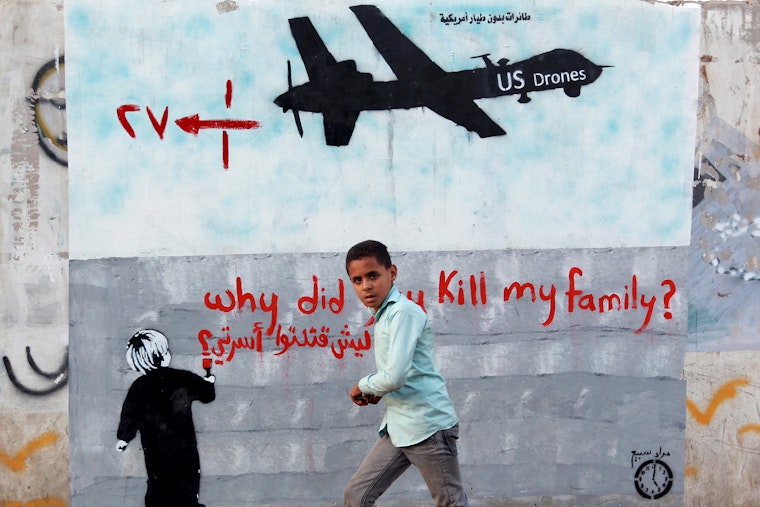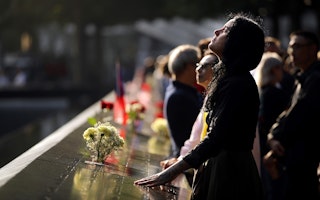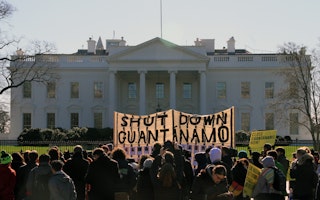Obama’s New Drone Policy Is a Step Forward for Transparency
By Toby Shepard

For Hussein Ahmed Saleh Bakr, April 19, 2014, began like any other day. The 24-year-old Yemeni laborer was on his way to work in central Yemen with his father, uncle, and nine others.
Suddenly, an armed U.S. drone, unseen in the morning sky, fired missiles at the car behind them. Shrapnel from the explosion hit Hussein’s truck, killing his family members and two other passengers, and injuring five others.
They were killed only because they happened to be in the wrong place at the wrong time. Hussein, his family, and his fellow passengers had no ties to terrorism whatsoever.
“None of us—all passengers of the car—had anything to do with al-Qaeda or any other organization. No committee has come to us to investigate the incident,” Hussein told researchers from the Yemeni human rights organization Mwatana for a joint report with the Open Society Justice Initiative after the attack. “We want fair compensation for us because we are poor families. We want the perpetrators of this crime to be held accountable for what they have done.”
Hussein’s story raises questions about the U.S. government’s reliance on armed drones as a central tool for counterterrorism operations in places like Yemen, Pakistan, and Somalia. His story also offers powerful evidence for why U.S. drone strikes, the overwhelming majority of which are conducted in secret, need to be more transparent and accountable.
Earlier this month, Obama’s director of national intelligence took a step towards making this happen by releasing estimates of the number of combatants and civilians who have been killed by U.S. drones since 2009. President Obama also signed an executive order requiring future presidents to release similar information annually.
Human rights advocates, journalists, and others question the accuracy of the government’s civilian casualty numbers. Nevertheless, the release of this data will provide the American people the basic information needed for a thoughtful debate about the ethics, efficacy, and wisdom of the administration’s drone policy.
Of course, the civilians killed by U.S. drone strikes are more than just statistics. They are real people with families, stories, and dreams for a better future. They live in fear that they or their loved ones could be killed at any moment by an armed drone.
President Obama’s executive order outlines a process by which the U.S. government must review and investigate incidents of civilian harm, taking into account information from all available sources, including civil society organizations. According to the executive order, the U.S. government must acknowledge responsibility for civilian deaths and injuries and provide redress to the victims and their families. This policy will mean a great deal to people like Hussein, whose families suffer the consequences from U.S. drone strikes long after the smoke clears.
The impact of drone strikes on civilian communities, including economic hardship, displacement, trauma, stigma, and retaliation, gets little attention in policy debates about counterterrorism. When policymakers fail to pay attention to civilians affected by drone strikes, they risk alienating the very communities they need to support in order to address the threat posed by violent extremism around the world.
Mohammed Nasser al-Jarrah, another witness to a drone strike in Yemen, sums up how such strikes can exacerbate feelings of alienation and resentment toward the United States. “Our villages are poor—no education, no hospitals, no roads, nor any services,” he says. “Of all the progress and advances in the modern world, only these deadly missiles reached us.”
Taken together, the release of the civilian casualty estimates and the executive order on civilian protection are an important step on the path to greater transparency and accountability in the U.S. lethal drone program. Future disclosures—provided they contain more detailed information—will allow a more informed debate about U.S. policy on armed drones among administration officials, Congress, and the public.
While many aspects of U.S. counterterrorism operations are still secret, and many questions remain, these new steps will hopefully give victims, like Hussein, and their families some of the answers that they seek about why their family members were killed.
In his speech at the National Defense University in May 2013, President Obama said that the decisions we make about our use of drones “will define the type of nation—and world—that we leave to our children.” The Obama administration should continue to release more information about the U.S. drone program in order to make that world a more open and transparent place.
Until March 2017, Toby Shepard was a senior policy associate with the Washington, D.C., office of the Open Society Foundations.


